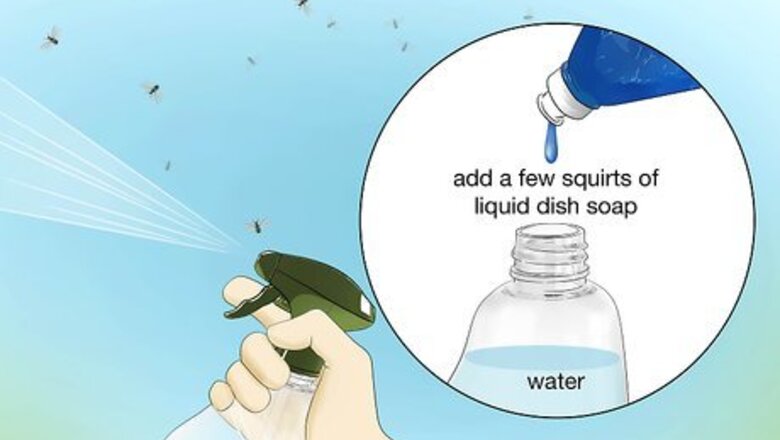
views
- Use a commercial pesticide labeled for ant use to kill any flying ant inside or outside.
- Make a natural DIY pesticide by mixing water and peppermint oil in a spray bottle.
- Purchase a bug zapper for a hands-free solution that kills flying ants on the spot with little to no work.
Immediate Solutions

Spray the ants with dish soap. Dish soap is an effective DIY way to kill flying ants. The soapy substance sticks to the ants’ bodies and dehydrates them, killing them on impact. Make a dish soap solution by filling an empty spray bottle with water and putting in a few drops of dish soap. Then, spray the ants in flight or at rest.
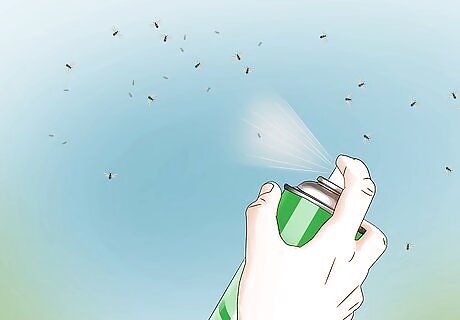
Use a commercial aerosol to kill all types of ants on contact. There are a variety of commercial bug poisons that’ll kill flying ants. Head to your local hardware or department store to pick up an ant spray. Then, spray the ants with the poison mid-flight to kill them on impact. Always follow your chosen ant spray’s instructions to ensure you use the product correctly. Never direct aerosol poisons at any other person or animal in your household. Make sure your poison is safe for indoor use if you plan to kill flying ants indoors. These will be marked as “indoor ant sprays” on the product’s label.

Make a natural peppermint spray. Peppermint oil is an effective and holistic way to kill flying ants indoors and odors. Simply mix 1 drop of peppermint oil with every 1 L (34 fl oz) of water in a spray bottle. Then, spray the area where the ants are most active or on them mid-flight. Alternatively, place cotton balls soaked in peppermint oil in areas where the ants are, as this can deter their path and make them leave.
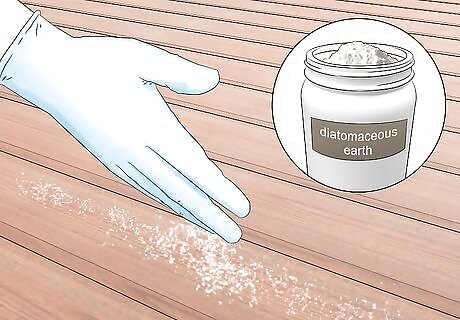
Lay out some food-grade diatomaceous earth. Diatomaceous earth works against ants by causing dehydration and death. The substance isn’t harmful to humans or pets, making it a perfect pesticide for your home. Simply sprinkle the powder in areas where you suspect or see ants, such as entranceways or crevices, to deter them from entering your home. Make sure you purchase food-grade diatomaceous earth, as this is non-toxic to everything but insects. Avoid placing diatomaceous earth on wet surfaces, as the powder only works when dry. Since the ants must cross into the diatomaceous earth directly, there’s no guarantee it’ll be effective against flying ants. Even so, it’s worth trying to fool the ants.
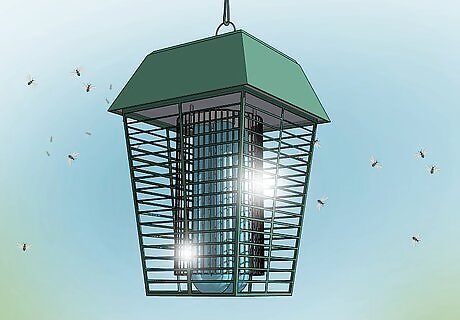
Invest in a bug zapper. An electric bug zapper can be a great solution to getting rid of flying ants in your backyard living spaces. Hang the zapper in an area you typically see flying ants in, such as the corner of a porch or gazebo. Then, wait for the device to zap and kill the flying pests on impact. Hang the zapper in an open location that is out of reach of children and pets. Keep in mind that some electric bug zappers need to be plugged into an electrical socket to work. An extension cord may be needed to hang and operate the zapper properly. Follow the instructions on your chosen zapper carefully to ensure you install and use it correctly.
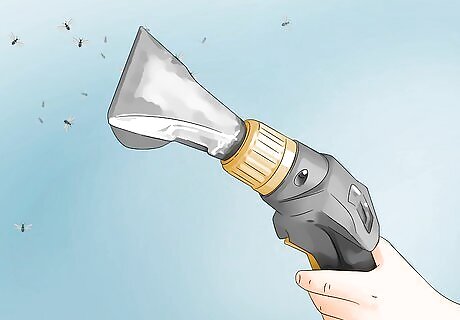
Vacuum up the flying ants. An easy and inexpensive way to get rid of flying ants in your home is to take out the vacuum and suck them up. Use the nozzle end of your vacuum to catch them mid-flight or suck them off the floor. Keep in mind that this method isn’t a sure way to kill or prevent the ants from returning. This is a short-term solution to remove ants quickly and effectively.
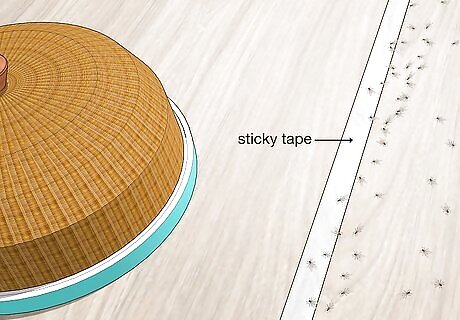
Trap ants with tape. Believe it or not, a barrier of sticky tape can be enough to catch flying ants before they take off. Lay a perimeter of tape around potential food sources, such as a pantry or fruit bowl. Then, when the ants land and start crawling toward the food, they’ll get stuck on the tape and eventually die. Use double-sided tape for the best results. Keep in mind that this DIY trap may not be 100% effective on flying ants since flying ants could potentially fly over the tape. While there is no guarantee you’ll catch any ants, this non-toxic, inexpensive option may still be worth a try.
Attacking the Colony
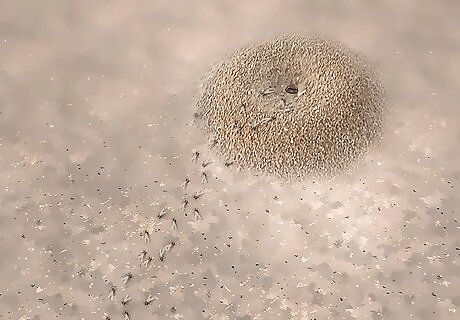
Track down the nest. In order to get rid of the flying ants for good, you have to follow them back to their nest or colony. Killing the colony of ants provides a more permanent solution and prevents future ants from entering your space. To find a nest, leave the ants alone and follow them. They’ll likely head back in a group or line after getting food. Don’t be surprised to see regular-looking ants when you find a flying ant’s nest. Flying ants grow their wings when fully mature, meaning most of their brothers and sisters are wingless.
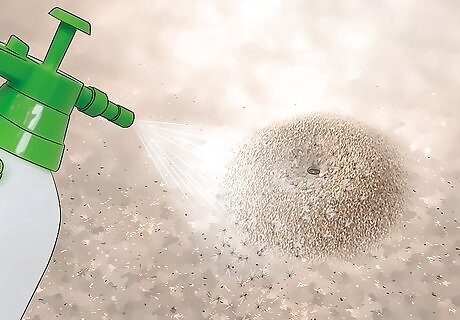
Use a commercial pesticide. Ant bait and other commercial poisons are effective against flying ants as long as they’re labeled for use against ants in general. Place the pesticide near the nest (or in the area you believe it to be) following the instructions on the product’s label. Look for granules or powder pesticides the ants will carry back to help kill the entire colony. Note that ant baits can be sugar- or protein-based. Different bases can attract different species of ants, so if one doesn’t work, try another with a different base type. Don't expect to get rid of ants within 24 hours. Ants have 4 lifecycle stages, and each stage needs to be exposed to insecticides before they die. So, it can take up to 2 weeks for an ant problem to be completely under control.

Create a trap with borax and sugar. Borax is highly toxic to ants, but if you mix it with something sweet, the ants can be tricked into thinking it’s a delicious treat. Follow these instructions to make DIY borax ant bait: Mix ⁄4 c (12 US tbsp) of powdered sugar with ⁄4 c (4.0 US tbsp) of borax. Place the mixture onto a piece of cardboard. Set the cardboard in an area where the flying ants are known to linger, and wait for the ants to retrieve the bait and bring it back to their colony. Borax can be poisonous to children and pets, so be sure to place it out of reach of curious hands and paws.
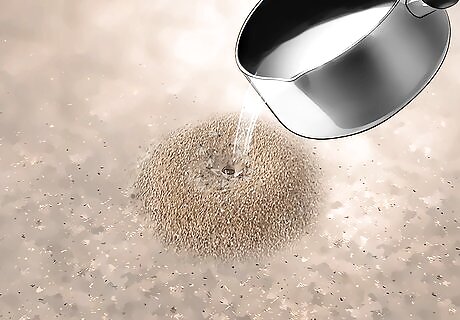
Pour boiling water over the nest. If you’ve found the ant colony, try using boiling water to flood them out of their home. Boil a kettle or pot of water, head out to the anthill, and slowly dump the water over it. The ants will be scalded by the heat and die inside their nest. Place a flowerpot upside down over the anthill before you boil the ants out. Pour the water onto the anthill through the drain hole at the bottom of the pot. Doing this traps the ants while protecting you from bites and stings from any escapees. Over the years, there’s been some debate over this ant-killing method. Some homeowners claim it works, while most experts say it’s ineffective.
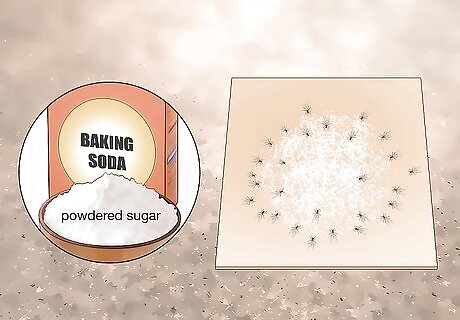
Set a trap using baking soda and powdered sugar. Baking soda is another natural material that can kill ants but requires a bit of disguising. Mask the odor of the baking soda by mixing it with equal parts of powdered sugar. Then, place the mixed powder on a piece of cardboard near the anthill. Wait for the ants to collect the bait and bring it back to their colony, killing themselves in the process.

Kill the ants with artificial sweetener. Artificial sweeteners can be extremely toxic to ants, yet the sweet scent is often enough to lure them in. Sprinkle an artificial sweetener where the ants like to fly or roam. Then, wait for the ants to return and collect the small granules. They’ll bring the “food” back to their queen, killing her and the rest of the colony. As an alternative, mix a little artificial sweetener with some apple juice, adding just enough apple juice to form a paste. The ants will eat some of this paste and carry the rest back to the colony. Once consumed there, the ant population dwindles. Keep in mind that this DIY method isn’t foolproof or without fault. In some studies, aspartame was proven an effective ant killer, while other studies have diffused this claim.



















Comments
0 comment